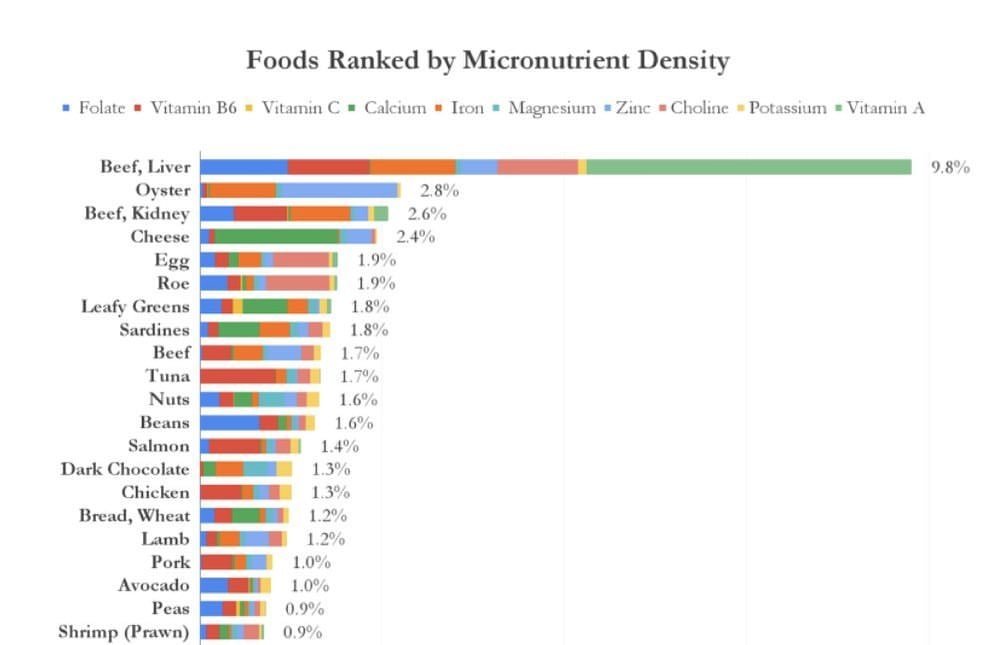Beef liver outshines other foods when ranked by micronutrient density.
Beef liver. It’s the king of nutrition that hardly anyone wants to eat. Liver and onions was once a mainstay of American diets. This tradition sadly faded in America when eating offal became associated with poverty, as the cuts of organ meats were the least expensive. Over time, families stopped preparing organ meats regularly in favor of more “choice cuts” as the American middle class grew. Because many were not exposed to the tastes and textures of organ meats in early childhood, liver is now undesirable for most people. However, there are many reasons to bring back eating liver, chief among them being nutrition.
Why Eat Grass Fed Beef Liver
Saint John’s organic, grass-fed beef liver.
In nature, it’s common to see predators prioritizing liver and other organ meats over the muscle meats, often leaving the muscle meats for scavengers to eat. In wolf packs, the alpha wolf gets first dibs on the liver, and orcas are known to kill a shark just for its liver. There is some wisdom here beyond science, and it’s intimating not to skip the liver.
Iron and Vitamin A
Liver is a rich source of iron and vitamin A, and is well known as essential to recovery from anemia. It’s the most concentrated dietary source of vitamin A, a vitamin key for vision, reproduction, and immune system function. The vitamin A from liver is in retinoid form, the form in which our bodies are most easily able to absorb and assimilate the vitamin A. Compared to carotenoids (as in beta-carotene from carrots and other yellow and orange vegetables),
There’s an association between carrots, sweet potatoes, and other orange and yellow vegetables and vitamin A, with their pigmentation as a supposed indicator of beta-carotene. It’s a common misconception that beta-carotene is vitamin A. In truth, carotenes are a precursor to vitamin A, and most humans can convert beta-carotene to vitamin A. Our genetics and gut health determine if, and to what extent, we are able to convert beta-carotene into usable vitamin A.
For example, let’s compare carrots and beef liver. 100 grams of cooked carrot contains about 10,200 mcg of vitamin A in beta-carotene form, but only 852 mcg will be converted to active retinol form, given good gut health and genetics. Only 8% of the beta-carotene was convertible to active vitamin A in this case. In stark contrast, 100 grams of cooked beef liver contains 7700 mcg of vitamin A, all of it preformed and ready to be absorbed.
Classic Liver Preparation: Liver & Onions
You can’t go wrong with liver and onions...unless you don’t like the taste of liver. Here are a few tips to make an honest liver dish a little more palatable.
Soak liver in milk, buttermilk, or whey for a few days prior to cooking. This is a traditional cooking method that helps to remove some of the pungent flavor.
Pile high the onions.
Use bacon and bacon fat. Bacon and bacon fat make everything more delicious, including liver!
Don’t overcook, a little pink is best to maintain a creamy texture and prevent a leathery, overcooked texture.
My Favorite, Painless Way to Eat Beef Liver
Here is how to eat liver…advice that goes beyond “buck up” or “plug your nose”.
My favorite way to eat liver is to whiz it up in the food processor and use it in any of my dishes that use ground beef or other ground meats. I’ve found that by adding a little ground liver to those dishes, we usually don’t notice the taste and neither do our dinner guests! I stick to a ratio of ⅓ lb liver to 1 lb ground beef. If you’re feeling hesitant or you know that you really don’t like the taste of liver, lower that ratio to ¼ lb or even ⅙ lb. It’s important that you enjoy your food and have success while still adding a powerful nutritional boost to your meals.
Saint John’s liver in the food processor, before being ground up.
Pulse the liver until the desired texture is reached, it should look somewhat liquid-y.
Ground up liver.
If you don’t have a food processor, try cutting the liver into small pieces to resemble ground beef. If you go this route, freeze the liver for 30 - 60 minutes until it is semi-frozen. This will help with the slippery texture of liver and make cutting much easier.
If the liver taste ends up being too strong throughout the dish, add more hot sauce, ketchup, or other acidic condiments, and take a deep breath. Allow yourself to experience a new taste and texture, knowing the good you are doing for yourself.
Recommended Recipes
For grinding liver in the food processor, I recommend recipes that have some acid or spice to them, and I’ve found Asian dishes really don’t pair well with added ground liver. Spicy dishes like tacos or enchiladas and acidic, tomato-heavy bolognese are ideal.
My favorites include:
Taco meat
Bolognese / spaghetti meat sauce
I haven’t tried adding it to burgers, but I bet that would be delicious!
Liver, an ancestral superfood, has fallen out of fashion in recent decades, but it certainly deserves a place on our plates, for our benefit! If you try one of these methods for eating beef liver, let us know by tagging us on Instagram or Facebook!
We have organic, grass-fed, grass-finished beef liver available, please contact us for more information.



